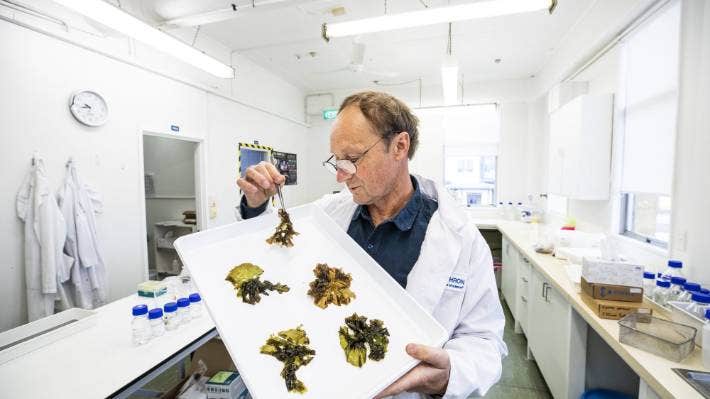Cawthron Institute and iwi partners secure Vision Mātauranga Capability Fund support for collaborative seaweed research
10 April 2025
Cawthron Institute and iwi/hapū research partners are celebrating the success of two mātauranga Māori focused research projects that have secured funding through the 2025 Vision Mātauranga Capability Fund (VMCF), administered by the Ministry of Business, Innovation and Employment (MBIE).
The VMCF supports initiatives that strengthen Māori research capability and enable Māori to participate in science and innovation, with a focus on harnessing the distinctive contribution of mātauranga Māori to research, science and technology.
These two successful projects highlight the power of co-developing science with hapū and iwi partners to address environmental challenges and protect culturally significant taonga species.

Image: Dr Tom Wheeler with seaweed samples in Cawthron Institute’s Whakatū Nelson laboratories.
Project One: Te Ara Teitei – Ensuring a healthy future for karengo
Led in partnership with Te Rūnanga o Kaikōura, this project focuses on karengo (a type of edible red seaweed closely related to Japanese nori) found along the Kaikōura coastline. Revered by Māori for generations as a nutritious delicacy and environmental indicator, karengo is now the subject of an innovative research initiative blending mātauranga Māori and ecological science.
By drawing on pūrākau (stories) from the Kaikōura-based hapu, Ngāti Kuri, and using them to guide scientific research questions, the project seeks to deepen understanding of karengo’s biology, its life cycle, and its vulnerability to environmental change.
“This is an opportunity to record the mātauranga held by Ngāti Kuri about this taonga species, while also building new scientific understanding that supports kaitiaki to make decisions for the future,” said Tom Wheeler, Senior Scientist at Cawthron Institute. “Together, we’re developing a community engagement programme to maintain and strengthen cultural connection with karengo and the marine environment.”
This project will involve collaboration with researchers from The University of Canterbury, Te Rūnanga o Kaikōura Limited and Cawthron Institute.
Project Two: Kaitiaki whai whakamāramatanga: Assessing seaweed bloom events for improved ecosystem management
This collaborative project with the Whangārei Harbour Kaitiaki Roopū will enhance collective understanding about increasing rimurimu (seaweed) strandings along the Whangārei coast, which are affecting coastal ecosystems and hapū wellbeing. It will also investigate opportunities arising from these events.
Cawthron Institute Geospatial Data Scientist Lisa Floerl who is co-leading the project said the team is grateful for the opportunity to build the relationships, tools and pathways needed to deepen knowledge and support kaitiakitanga.
“Together, we will co-design a web-based app to record seaweed stranding observations, reaching out hāpori and the wider community to learn more about where and when these events are occurring.”
These observations, along with satellite imagery, will be used to map the extent of stranded or floating rimurimu, exploring patterns in space and time that may hold the key to drivers of events. Species identification skills and knowledge will be supported by toolkits and wānanga, and the chemical composition of dominant species will be profiled to investigate potential uses.
The project honours mātauranga Māori as a holistic knowledge system that embraces scientific observation and technological innovation. By working together, collaborators hope to build practical, culturally grounded tools that help hapū respond to environmental change while also identifying opportunities for resilience and regeneration.
This project will involve collaboration between researchers from Cawthron Institute, the Hauāuru Trust Working Group (representing Whangārei Harbour Kaitiaki Roopū) and staff at Northland Regional Council.
Cawthron Institute’s Māori / Indigenous Research & Development Programme Coordinator Marcus Tuwairua says both projects exemplify how blending mātauranga Māori with scientific inquiry can strengthen kaitiakitanga and lead to more holistic, place-based environmental solutions.
“These partnerships are about restoring and revitalising traditional knowledge, while also equipping communities with new insights and tools,” he says. “The outcomes won’t just be scientific – they’ll be social, cultural, and deeply intergenerational.”
In addition to the two proposals which have been successful, two other proposals submitted by Cawthron are ‘In Reserve’, meaning they could be approved if additional funding becomes available.
The approved projects will commence in June 2025.